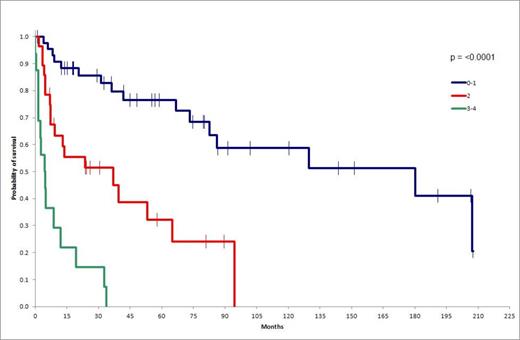Abstract
Background: Patients (pts) with classical Hodgkin Lymphoma (CHL) older than 60 years represent about 15% to 20% of CHL pts in population registries. Elderly CHL treated with standard protocols always have a poorer outcome as compared to younger pts. The aim of this retrospective study is to identify specific prognostic factors in a cohort of 165 CHL pts aged over 60 years.
Methods: From two hospital registries in Lyon (France), we analyzed 165 CHL pts older than 60 years and treated between 1981 and 2012. None were HIV positive. The following clinical characteristics were recorded: age, gender, presence of B-symptoms, ECOG performance status (PS), Cumulative Illness Rating Scale (CIRS), Ann Arbor stage, bone marrow involvement, complete blood counts, lactate deshydrogenase(LDH), C-reactive protein (CRP), fibrinogen, serum albumin level and protein electrophoresis. International Prognostic Score (IPS) was collected for 116 pts (70%). A total of 136 pts (82%) were treated with an anthracycline based chemotherapy (CT) and 53 pts (32%) received radiation therapy. Clinical and biological characteristics at diagnosis were assessed by a Cox regression for univariate and multivariate analysis for progression free survival (PFS) and overall survival (OS). We then designed a prognostic score for PFS and OS based on significant variables from multivariate analysis at threshold p-value < 0.5 and compared the effectiveness of these scores to IPS by a receiver operating characteristic (ROC) analysis.
Results: The median age at diagnosis was 69 years (range, 60-89). 60% were male, 65% presented with B-symptoms, 38% had a PS> 2 and 16% had at least one comorbidity scored 3 or 4 on CIRS. 56% had an Ann Arbor stage III-IV.65% of pts achieved a complete or a partial response, 16% were refractory or progressed within 6 months after the start of treatment and 19% died during treatment.
Median follow up is 65 months (1.1-207.6).
47 pts (29%) have progressed or relapsed. Median duration of PFS is 39.6 months (95%CI: 23.9-73.3) with a 4-year PFS rate of 49% (95%CI: 40-56).
78 pts (47%) died, 22% within the first year after treatment initiation. Median duration of OS is 73.3 months (95%CI: 38.5-129.8) and the 4-year OS rate is 55% (95%CI: 47-63). The main causes of death were HL progression (39%), infection (17%), treatment toxicity (13%) and second cancer (10%).
Pts treated with or without an anthracycline based CT did not have significantly different 4-year PFS (50% vs. 43%, P=0.55) or OS (57% vs. 47%, P=0.22).
In univariate analysis, age, B-symptoms, PS, CIRS, albumin, hemoglobin, lymphocyte count, bone marrow involvement, Ann Arbor stage, protein, gammaglobulin, fibrinogen, LDH and CRP were associated with a shortened PFS. Factors associated with a shortened OS were: sex, age, PS , CIRS, albumin, hemoglobin, lymphocyte count, bone marrow involvement, Ann Arbor stage, protein, CRP, gammaglobulin and fibrinogen.
In multivariate analysis, age>69 years (HR=3.97; 95%CI: 2.11-7.47, P<0.0001), bone marrow involvement (HR=2.09; 95%CI: 1.11-3.91, P=0.02), gammaglobulin level<10g/L (HR=2.43; 95%CI: 1.31-4.50, P=0.005) and fibrinogen level>5g/L (HR=2.29; 95%CI: 1.25-4.19, P=0.007) were independently associated with a shortened PFS. Pts with 0-1, 2 and 3-4 adverse factors had a median duration of PFS of 180, 37 and 4.6 months respectively (Figure, P=<0.0001). In multivariate analysis, factors independently associated with a poor OS were age>69 years (HR=3.66; 95%CI: 1.95-6.85, P<0.0001), PS > 2 (HR=3.04; 95%CI: 1.69-5.45, P=0.0002) and gammaglobulin level<10g/L (HR=2.26; 95%CI: 1.25-4.07, P=0.007). Pts with 0, 1, 2 and 3 adverse factors had a median duration of OS of 180, 73, 21.5 and 3 months respectively (P<0.0001). Eventually, evaluation of our model by ROC analysis showed a better predictive value than IPS for PFS (0.69 vs. 0.54, P=0.01) and OS (0.74 vs. 0.60, P=0.02) .
Conclusion: This prognostic score identifies subgroups of elderly CHL pts at high risk of progression and early death, using simple biological and clinical parameters at diagnosis. Bone marrow involvement is one of the factors independently associated with PFS. This result supports bone marrow evaluation at diagnosis. This score better discriminates elderly CHL pts’ outcome compared to IPS. Our results should be confirmed in independent and prospective studies in combination with complete geriatric assessment.
No relevant conflicts of interest to declare.
Author notes
Asterisk with author names denotes non-ASH members.


This feature is available to Subscribers Only
Sign In or Create an Account Close Modal